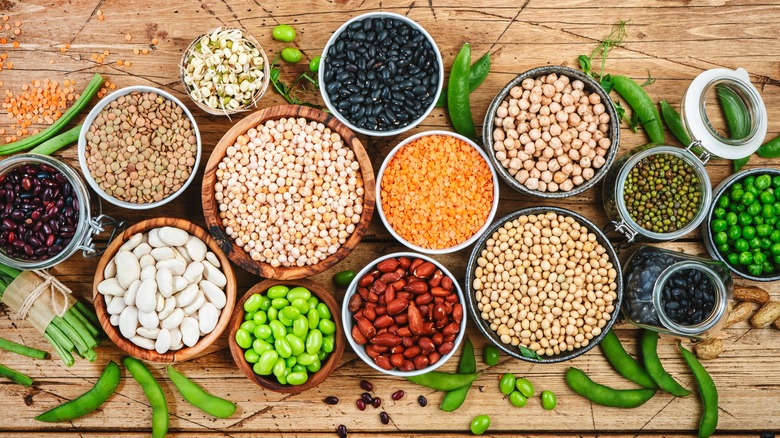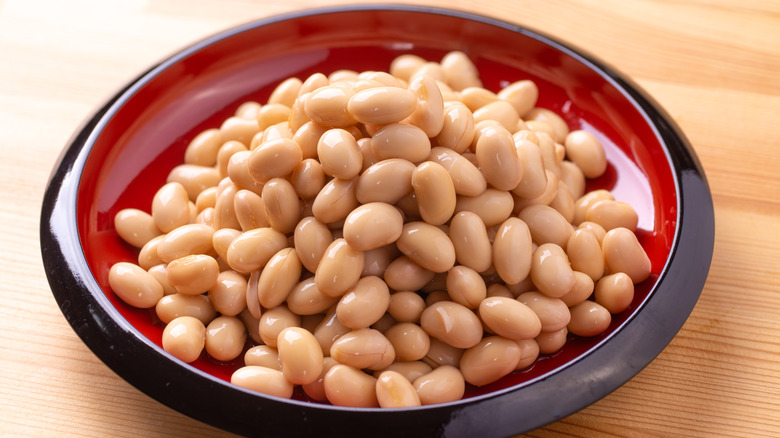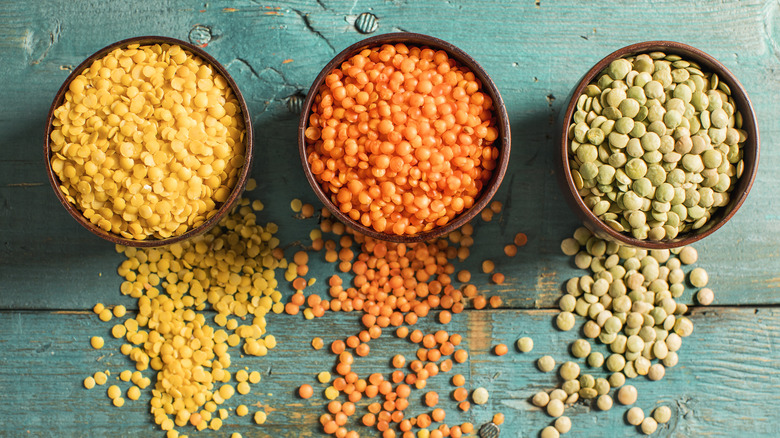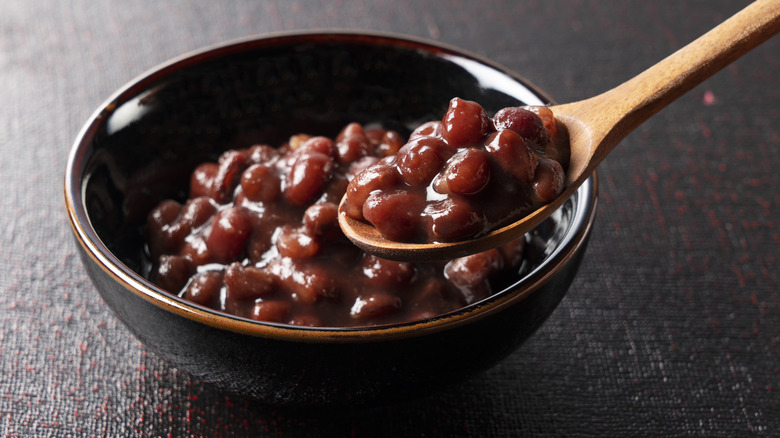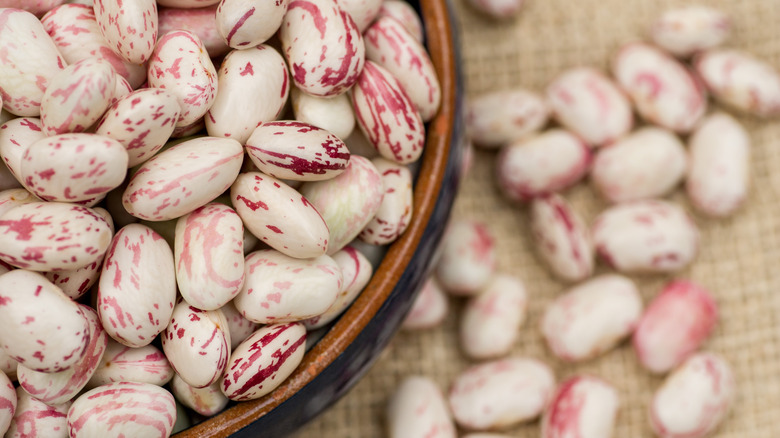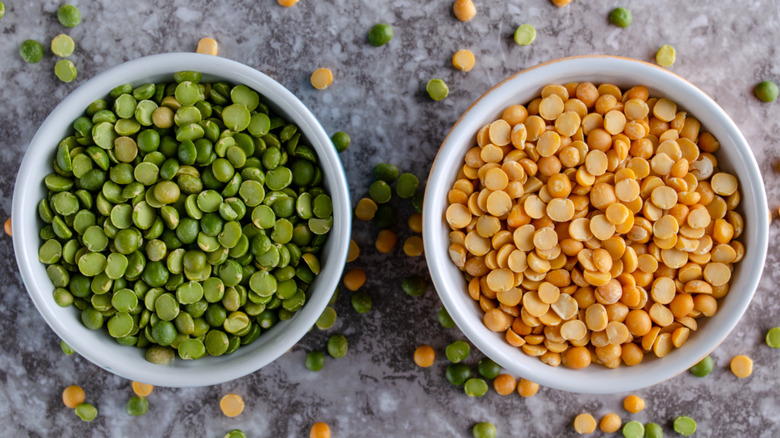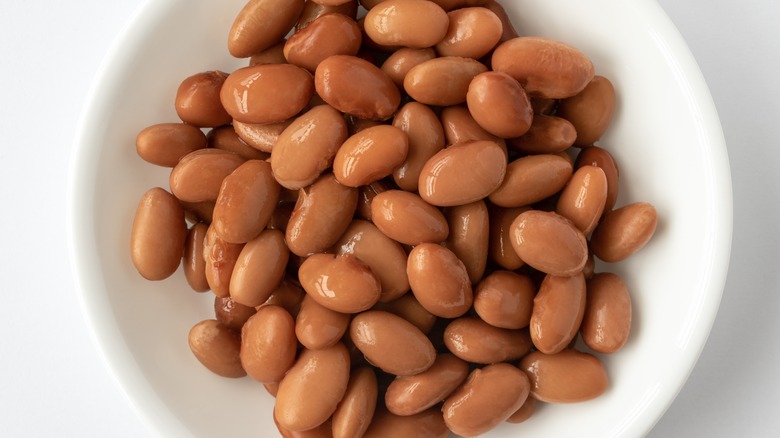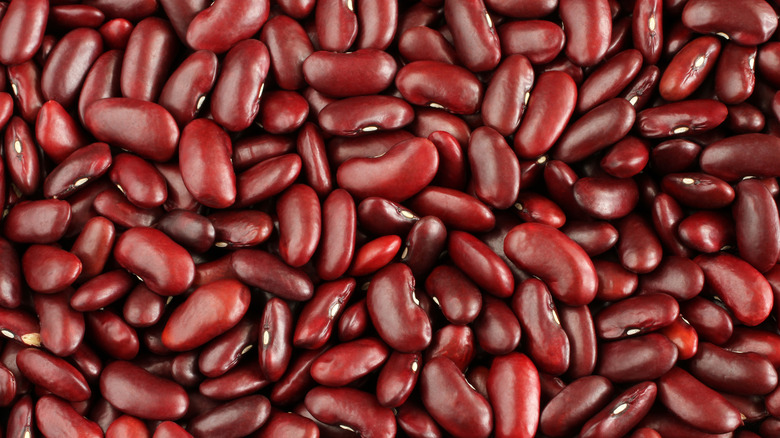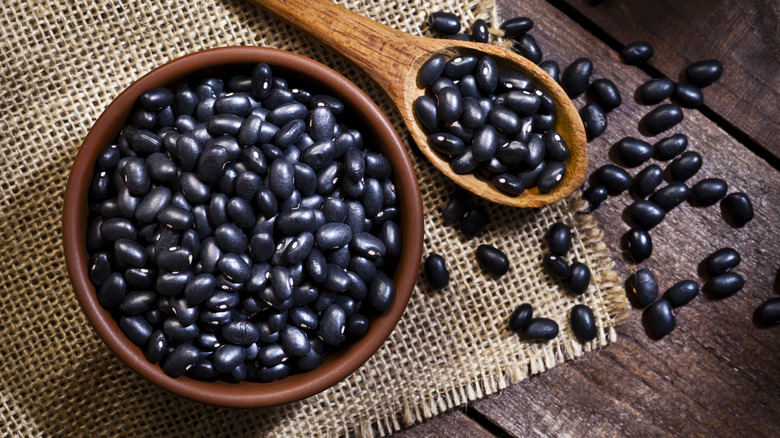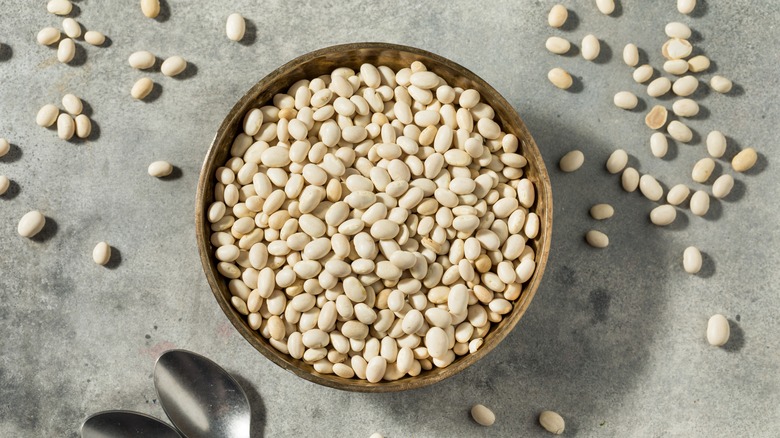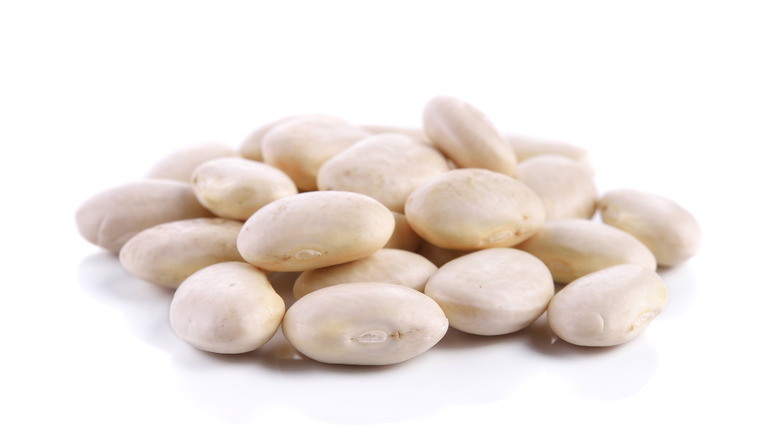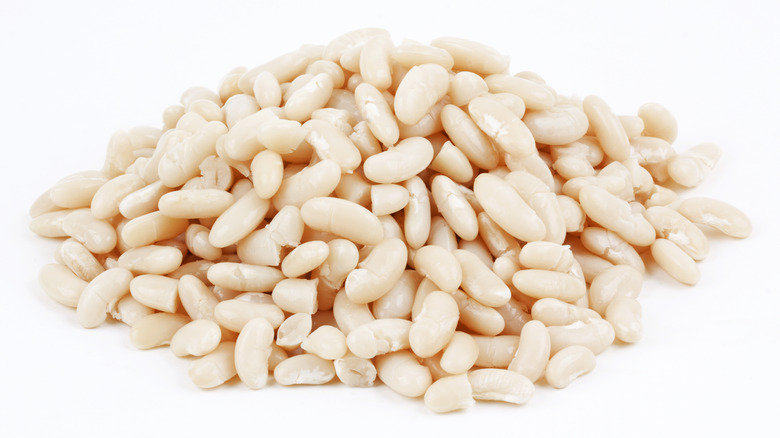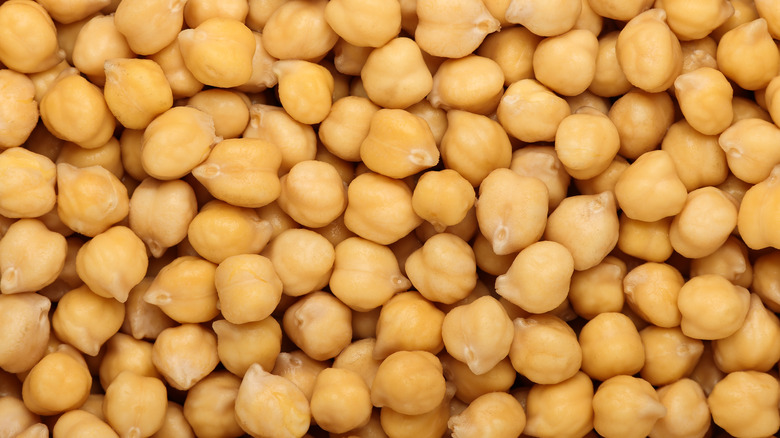12 Types Of Beans And Legumes That Have The Most Protein
Beans and other members of the legume family are renowned for being nutritious, delicious, and convenient pantry staples. These versatile ingredients are perfect for tossing into soups, stews, salads, and chilis, adding bite, sustenance, and a wholesome feel to any dish. They're rich in fiber, as well as other essential vitamins and minerals, but one of the key health benefits we can reap by enjoying legumes in our diets is their high protein content. Protein is a vital component of a balanced diet, playing a key role in building and repairing muscle, as well as supporting the immune system by forming antibodies that fight infections. Whether you're a dedicated vegetarian or vegan, or just keen to diversify your diet, feasting on a variety of beans and legumes can significantly boost your protein intake.
From the well-known soybeans and hearty lentils, to less common varieties like cranberry beans and split peas, there are so many options available. But, which ones can offer the most protein? We're exploring 12 of the most protein-rich beans and legumes, delving into the exact figures and helping you decide which type to reach for when whipping up your next bean-based recipe. The protein quantities in the list below refer to beans that have already been cooked by boiling, rather than their dried counterparts. So, read on to discover which varieties pack the most of this vital nutrient.
1. Soybeans
When it comes to protein content, soybeans take the top spot by a mile. Not only are these beans incredibly versatile, they boast an impressive 31 grams of protein per cooked cup.
One of the unique characteristics of soybeans, which are the mature form of edamame beans, is their complete protein profile. Unlike most plant-based proteins, soybeans are packed full of the nine essential amino acids. This actually makes them comparable to animal proteins. Soybeans are therefore a particularly great option for vegetarians and vegans who are looking to incorporate high-quality protein sources into their diets.
As well as being rich in protein, soybeans contain other nutrients including fiber, and vitamins and minerals like vitamin K, folate, copper, and manganese. Additionally, they have isoflavones, compounds that have been linked to various health benefits, including reducing the risk of developing certain cancers and improved bone health.
Soybeans can be enjoyed in many ways. Trying boiling the beans and enjoying them as a side dish or snack, or tossing them into a stir-fry. They are also used to make a whole host of plant-based products like tofu, tempeh, meat replacements, and soy milk, which all contain a significant amount of protein thanks to this mighty bean.
2. Lentils
Next up we have lentils, an unsung hero on the protein front, with a cooked cupful providing around 18 grams of this essential nutrient. These little legumes come in various colors – including green, brown, red, and yellow — with each offering a slightly different flavor and texture, so it couldn't be easier to incorporate them into your diet.
Cooking with lentils is the perfect way to inject some protein, along with other beneficial nutrients, into any dish. They fit seamlessly into a range of delicious recipes, from warming red lentil curry, to meatballs, and shepherd's pie. Green and brown lentils hold their shape well after cooking, so they're great for tossing into salads and stews. Red and yellow lentils, which tend to become more mushy when cooked, are perfect for soups and Indian dals, adding a lovely creamy texture.
In addition to protein, lentils are high in dietary fiber, which aids our digestion, and folate, which is essential for maintaining good heart health, and particularly beneficial for supporting fetal development in pregnant women. And it doesn't end there. Lentils are also an amazing source of a wide array of other nutrients, such as selenium, potassium, and iron.
3. Adzuki beans
A close third in the protein rankings, adzuki beans are another delicious option for boosting the nutrient content of your meals. Adzuki beans are a small, red variety of beans (also known as red mung beans) and a cupful of these cooked beans will provide just over 17 grams of protein.
Frequently used in East Asian cuisine, these beans have many applications in both sweet and savory dishes. They do not require soaking before cooking – just a quick rinse — and their relatively quick boiling time makes them a super convenient choice. One of the most common uses of adzuki beans is in the preparation of sweet red bean paste, which is used as a filling for mochi, pastries, and other Japanese-inspired desserts. This paste, known as anko in Japan, combines cooked adzuki beans with sugar, creating a delicious combination of sweet and earthy flavors and a wonderful, creamy texture.
In savory dishes, adzuki beans can be used in soups, stews, and salads. They pair well with grains like rice and quinoa, making them a great addition to hearty grain bowls. Additionally, adzuki beans can be sprouted and added to salads and sandwiches for a fresh, crunchy texture.
4. Cranberry beans
Cranberry beans, or borlotti beans, are perhaps one of the lesser known bean varieties, but they're absolutely worth incorporating into your diet. Packing just under 17 grams of protein per cooked cup, they're a substantial source of protein, taking fourth place in our lineup.
Originally cultivated in Colombia, cranberry beans have become a favorite in Italian, and Portuguese cuisines. The dried beans have a striking pink and beige speckled appearance, though once cooked they become light brown in color. Their creamy texture and slightly nutty flavor make them an amazing addition to a variety of dishes, from soups and stews to salads and casseroles. A classic Italian recipe which often features cranberry beans is pasta e fagioli, a hearty soup combining beans, pasta, and vegetables.
Nutritionally, cranberry beans can provide more than just protein. Firstly, they have a low glycemic index, which means they won't cause any drastic spikes in your blood sugar levels. Additionally, they provide important minerals such as phosphorus, magnesium, and potassium, which are helpful in maintaining health and bodily functions. These hearty beans are also rich in powerful antioxidants which have many health benefits.
5. Split peas
A legume that might not yet be commonplace in your meal repertoire is the split pea. These are a type of field pea, that come in both green or yellow varieties, and they pack about 16 grams of protein per cooked cup.
Cooking dried split peas is relatively straightforward as they do not require soaking. They will be ready in about 20 minutes when simmered in boiling water or broth, and can be tossed straight into soups and stews after a quick rinse. Since they're more commonly found in dried form in grocery stores, they're a great, cost effective ingredient that's perfect for buying in bulk and keeping stocked in your pantry. To make a classic split pea soup, first sauté onion, carrot, celery, and garlic. Then, add the dried split peas and vegetable stock, before leaving everything to simmer. You could also add some chunks of ham for a further boost of protein goodness.
Another popular way to use split peas is in an Indian-inspired dal. Here, the peas can be combined with spicy, aromatic flavors like ginger, turmeric, and chili, and simmered in a rich broth for a longer period of time which helps them to develop a smoother, creamier texture.
6. Pinto beans
Pinto beans are another excellent source of protein, with the figures coming in at just over 15 grams per cup of cooked beans. These are a much-loved staple, being a go-to in many of our favorite chili recipes, as well as being well-used in a range of Mexican-inspired dishes.
Pinto beans can of course be bought in their dried form, which are easily recognizable for their distinctive reddish-brown speckles, and will require soaking and boiling before eating. However, they are also readily available in handy canned form, where they come cooked and ready to use, though they lose their speckles to become a uniform brownish-pink color. Pinto beans lend themselves well to plenty of different dishes, from soups and salads to tacos and burritos. Try slow-cooking them in a spicy broth, or blending them in the much-loved Mexican side dish – refried beans. And of course, there's the classic chili con carne, where these beans can make the perfect complement to the rich flavors of the meat, tomatoes, and spices.
Enjoying these beans is also another fantastic way to get a hearty boost of fiber, to keep our guts healthy. We can also benefit from their high levels of vitamin B9 and iron, which are important for making red blood cells, as well as calcium, which contributes to the health of our teeth and bones.
7. Kidney beans
They're another favorite for tossing into a delicious homemade chili, and the protein content of kidney beans is not to be sniffed at. Coming in just below pinto beans, a cooked cup of these hearty red beans contains around 15 grams of protein.
There are so many reasons why these beans make a mean chili. Firstly, they're large in size, making your chili feel extra hearty, and they add a beautiful pop of color with their distinctive red hue. They also have a wonderful smooth, creamy texture, but will hold their shape well as they simmer away in the spicy, meaty broth. For a veggie version, try combining kidney beans with other varieties such as black beans and pinto beans to make a delicious three bean chili.
Kidney beans are also a popular ingredient in Caribbean cuisine, such as in rice and peas, where they are cooked with rice, coconut milk, and spices. Or, they can be tossed into a fresh, crunchy salad alongside cucumbers, tomatoes, red onion, cilantro, and a tangy dressing.
In their dried form, they require soaking before some lengthy simmering. Eating undercooked kidney beans can actually be dangerous, since they contain harmful toxins that must be broken down through the cooking process. To keep things quick and convenient, you can opt for canned beans, which are ready to eat after a simple drain and rinse.
8. Black beans
A staple in Latin American cuisine, black beans are a fantastic source of plant-based protein, providing about 15 grams of protein per cooked cup. These small, shiny legumes are super nutritious, with a creamy texture and a sweet, earthy flavor.
Incorporating black beans into your meals is a delicious way to boost your protein intake, and there are plenty of ways to use these tasty legumes. Black beans hold their shape very well during cooking, maintaining a slightly firmer texture than other types of legumes. This means they work fantastically in soups, stews, and chilis with long simmering times. Their hearty texture, along with their rich flavor, also helps them to serve as a great meat replacement, and they're often incorporated into vegetarian burgers, as well as burritos, tacos, dips, and rice dishes. Even sweet treats can benefit from the addition of black beans. Try whipping up some healthy black bean brownies or chocolate mousse for a protein-packed dessert.
Like other legumes, black beans are rich in fiber and a range of vitamins and minerals, though one distinct characteristic of this bean variety is the presence of anthocyanins. These are a type of antioxidant that give the beans their dark color, and when consumed, can help to protect the body from inflammation and oxidative stress.
9. Navy beans
A serving of navy beans will give you a hearty boost of protein, with one cup of cooked beans containing 15 grams of the good stuff. These small, white beans are also known as haricot beans, and they have a fairly mild, neutral taste, which makes them the perfect vehicle for soaking up other rich flavors in a dish.
One of the most popular uses of navy beans is in baked beans, a classic dish where the beans are slow-cooked with molasses, brown sugar, and spices. This delicious sweet and savory bean mixture makes a fantastic side dish for barbecues and gatherings. Navy beans are also a popular ingredient in soups, combined with veggies, broth, and sometimes meats like ham or chicken, for a super satisfying, warming meal. In blended soups, the beans can provide a wonderfully smooth, creamy texture.
Navy beans are not only packed with protein; they're also one of the most fiber-rich bean varieties, at about 19 grams per cup. Consuming plenty of fiber helps to keep the digestive system healthy, regulate blood sugar levels, and keep us feeling fuller for longer, so adding navy beans to your diet is a win-win!
10. Great Northern beans
Another beloved member of the white bean family, Great Northern beans also make the cut when it comes to their protein content. These versatile legumes will provide around 15 grams of protein per cooked cup.
Great Northern beans are a medium-sized variety of white bean, being slightly smaller than cannellini beans, but larger than navy beans. They're mild in flavor with a slightly nutty taste, come in both canned and dried form, and are a popular choice in a variety of dishes. For a simple yet flavorful side dish, the dried beans can be cooked in the instant pot with some water, garlic, oregano, and lemon juice. Or, why not blend them into a rich white bean hummus, using them in place of chickpeas. In fact, Great Northern beans actually have a smoother texture than chickpeas, which can result in an extra creamy dip.
The traditional French recipe, cassoulet, also features these protein-rich beans. Here, the beans are soaked and boiled before combining them with vegetables, sausages, and duck legs, in a herby, tomatoey sauce. This is then baked with a garlicky breadcrumb topping. The result is a wonderfully rich and hearty dish, with the beans adding bite and a wholesome, creamy element.
11. Lima beans
On par with Great Northern beans in the protein department, you'll find lima beans, which also contain about 15 grams of protein per cooked cupful. These large white beans are sometimes called butter beans, and they boast a tender and creamy texture. This name refers to the beans in their mature stage, where they are larger, flatter, and paler in appearance, most commonly coming in dried form. However, the beans can also be enjoyed when immature, where they're typically green, smaller in size, and available fresh rather than dried.
Butter beans can be added to stews, soups, and curries, creating a moreish, hearty texture and packing in plenty of nutrients, including copper, potassium, and vitamin C. They're often used in Mediterranean cuisine, cooked with spices, tomatoes, and other veggies, and sometimes a broth with the rich addition of cream or cheese. A traditional Indian curry called vaal nu shaak also features butter beans alongside punchy spices and aromatics such as tamarind, chili, cinnamon, ginger, and cloves. In Peruvian cuisine, cooked butter beans are blended and boiled in a mixture of sugar, evaporated milk, and cinnamon to make a creamy dessert called manjarblanco de pallares, also known as lima bean dulce de leche.
12. Chickpeas
One of the most popular legumes is the humble chickpea, which, despite the name, is in fact a bean. Chickpeas are also known as garbanzo beans, and one cooked cup of these beauties will provide you with just under 15 grams of protein.
Chickpeas certainly win points for versatility, with so many delicious ways to incorporate them into your meals. One of their most popular uses is in hummus, a creamy dip made by blending the chickpeas with tahini, olive oil, and garlic. They can also be coated in oil and spices before roasting them in the oven, to create a crunchy, healthy snack, that's amazing for topping salads or soups. They're also a key ingredient in falafel, where they're blitzed up with spices and aromatics, then formed into balls before frying.
These beans are also a fantastic ingredient for making a batch of protein balls, with their soft texture making them easy to blend with other add-ins like peanut butter, maple syrup, and chocolate chips. You can even make blondies and cookies with chickpeas, which can make a great alternative to flour for those following a gluten-free diet, and give a wonderfully chewy and gooey result whilst sneaking in some extra nutrients.
